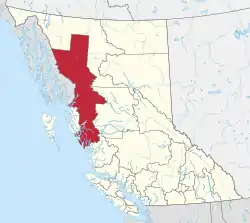Regional District of Kitimat–Stikine
The Regional District of Kitimat–Stikine is a local government administration in northwestern British Columbia, Canada.[3] As of the 2016 Canadian census, it had a population of 37,367 living on a land area of 104,464.61 square kilometres (40,334.01 sq mi). Its administrative offices are in the city of Terrace. The next-largest municipality in the regional district is the District Municipality of Kitimat. The other incorporated municipalities in the regional district are the Village of Hazelton, the District of New Hazelton and the District of Stewart. Unincorporated communities are many, most of them Indian Reserves which are not part of the governmental system of the regional district, which has limited powers relating mostly to municipal-type services. The remote settlement of Dease Lake, formerly in the Stikine Region, was added to the regional district on December 1, 2007. Thornhill is the largest unincorporated community in the regional District with a population of 5000+ residents.
Kitimat–Stikine | |
|---|---|
| Regional District of Kitimat–Stikine | |
 Terrace townsite | |
|
Logo | |
 Location in British Columbia | |
| Country | Canada |
| Province | British Columbia |
| Administrative office location | Terrace |
| Government | |
| • Type | Regional district |
| • Body | Board of directors |
| • Chair | Philip Germuth (Kitimat) |
| • Vice chair | James Cordeiro (Terrace) |
| • Electoral areas |
|
| Area | |
| • Land | 104,464.61 km2 (40,334.01 sq mi) |
| Population (2016)[2] | |
| • Total | 37,367 |
| • Density | 0.358/km2 (0.93/sq mi) |
| Website | www |
Municipalities
| Municipality | Government Type | Population |
| Terrace | city | 12,123 |
| Kitimat | district municipality | 8,335 |
| New Hazelton | district municipality | 666 |
| Stewart | district municipality | 494 |
| Hazelton | village | 270 |
Thornhill unincorporated municipality population 5123
Demographics
| Year | Pop. | ±% |
|---|---|---|
| 1996 | 43,618 | — |
| 2001 | 40,876 | −6.3% |
| 2006 | 37,999 | −7.0% |
| 2011 | 37,361 | −1.7% |
| 2016 | 37,367 | +0.0% |
| 2021 | 37,790 | +1.1% |
| Source: Statistics Canada | ||
As a census division in the 2021 Census of Population conducted by Statistics Canada, the Regional District of Kitimat–Stikine had a population of 37,790 living in 15,306 of its 17,386 total private dwellings, a change of 1.1% from its 2016 population of 37,367. With a land area of 104,307.25 km2 (40,273.25 sq mi), it had a population density of 0.4/km2 (0.9/sq mi) in 2021.[4]
| Panethnic group |
2021[5] | 2016[6] | 2011[7] | 2006[8] | 2001[9] | 1996[10] | ||||||
|---|---|---|---|---|---|---|---|---|---|---|---|---|
| Pop. | % | Pop. | % | Pop. | % | Pop. | % | Pop. | % | Pop. | % | |
| European[lower-alpha 1] | 21,590 | 57.93% | 21,960 | 59.45% | 23,040 | 62.23% | 23,850 | 63.07% | 27,975 | 68.7% | 31,230 | 71.89% |
| Indigenous | 13,415 | 35.99% | 13,265 | 35.91% | 12,660 | 34.19% | 12,275 | 32.46% | 10,960 | 26.92% | 10,210 | 23.5% |
| South Asian | 895 | 2.4% | 575 | 1.56% | 520 | 1.4% | 995 | 2.63% | 975 | 2.39% | 1,005 | 2.31% |
| Southeast Asian[lower-alpha 2] | 480 | 1.29% | 355 | 0.96% | 380 | 1.03% | 195 | 0.52% | 225 | 0.55% | 205 | 0.47% |
| East Asian[lower-alpha 3] | 435 | 1.17% | 330 | 0.89% | 250 | 0.68% | 285 | 0.75% | 235 | 0.58% | 480 | 1.1% |
| African | 230 | 0.62% | 210 | 0.57% | 40 | 0.11% | 85 | 0.22% | 170 | 0.42% | 160 | 0.37% |
| Latin American | 110 | 0.3% | 140 | 0.38% | 55 | 0.15% | 85 | 0.22% | 135 | 0.33% | 75 | 0.17% |
| Middle Eastern[lower-alpha 4] | 45 | 0.12% | 25 | 0.07% | 0 | 0% | 0 | 0% | 10 | 0.02% | 30 | 0.07% |
| Other[lower-alpha 5] | 70 | 0.19% | 80 | 0.22% | 55 | 0.15% | 40 | 0.11% | 35 | 0.09% | 50 | 0.12% |
| Total responses | 37,270 | 98.62% | 36,940 | 98.86% | 37,025 | 99.1% | 37,815 | 99.52% | 40,720 | 99.62% | 43,440 | 99.59% |
| Total population | 37,790 | 100% | 37,367 | 100% | 37,361 | 100% | 37,999 | 100% | 40,876 | 100% | 43,618 | 100% |
- Note: Totals greater than 100% due to multiple origin responses.
Notes
- Statistic includes all persons that did not make up part of a visible minority or an indigenous identity.
- Statistic includes total responses of "Filipino" and "Southeast Asian" under visible minority section on census.
- Statistic includes total responses of "Chinese", "Korean", and "Japanese" under visible minority section on census.
- Statistic includes total responses of "West Asian" and "Arab" under visible minority section on census.
- Statistic includes total responses of "Visible minority, n.i.e." and "Multiple visible minorities" under visible minority section on census.
References
- "Board of Directors". Retrieved July 9, 2019.
- "Regional District of Kitimat–Stikine". BC Geographical Names.
- "Population and dwelling counts: Canada and census divisions". Statistics Canada. February 9, 2022. Retrieved April 3, 2022.
- Government of Canada, Statistics Canada (October 26, 2022). "Census Profile, 2021 Census of Population". www12.statcan.gc.ca. Retrieved February 23, 2023.
- Government of Canada, Statistics Canada (October 27, 2021). "Census Profile, 2016 Census". www12.statcan.gc.ca. Retrieved February 23, 2023.
- Government of Canada, Statistics Canada (November 27, 2015). "NHS Profile". www12.statcan.gc.ca. Retrieved February 23, 2023.
- Government of Canada, Statistics Canada (August 20, 2019). "2006 Community Profiles". www12.statcan.gc.ca. Retrieved February 23, 2023.
- Government of Canada, Statistics Canada (July 2, 2019). "2001 Community Profiles". www12.statcan.gc.ca. Retrieved February 23, 2023.
- Government of Canada, Statistics Canada (June 4, 2019). "Electronic Area Profiles Profile of Census Divisions and Subdivisions, 1996 Census". www12.statcan.gc.ca. Retrieved February 23, 2023.